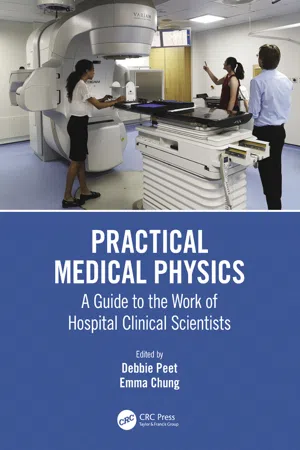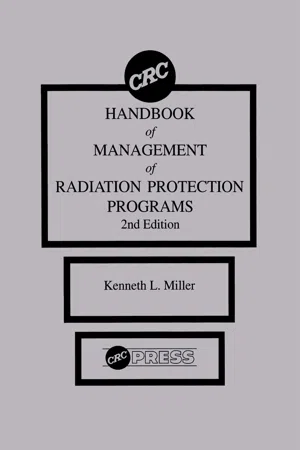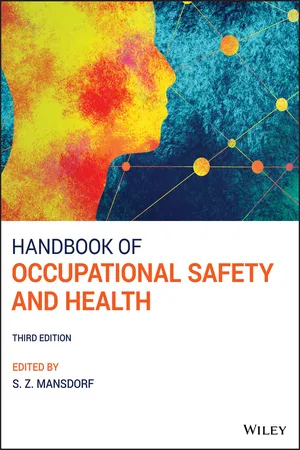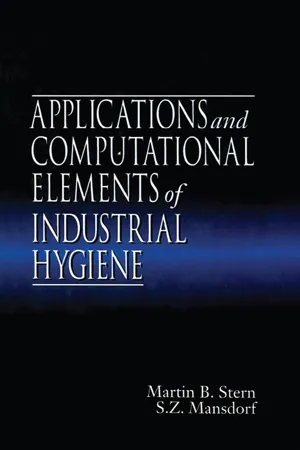Physics
Non Ionising Imaging
Non-ionizing imaging refers to medical imaging techniques that do not use ionizing radiation, such as X-rays. Instead, it utilizes non-ionizing radiation sources like ultrasound, magnetic resonance imaging (MRI), and optical imaging. These methods are considered safer than ionizing radiation-based imaging techniques and are commonly used for various diagnostic purposes.
Written by Perlego with AI-assistance
Related key terms
Related key terms
1 of 4
Related key terms
1 of 3
6 Key excerpts on "Non Ionising Imaging"
- eBook - ePub
Practical Medical Physics
A Guide to the Work of Hospital Clinical Scientists
- Debbie Peet, Emma Chung(Authors)
- 2021(Publication Date)
- CRC Press(Publisher)
Part I Non-Ionising ImagingThe NHS performs millions of imaging tests each year, with the most common being plain X-ray radiography, followed by diagnostic ultrasound, X-ray computerised axial tomography (CT scans) and magnetic resonance imaging (MRI). Part 1 of this book covers non-ionising (MRI and ultrasound) imaging. Ionising imaging using X-rays and molecular imaging techniques in Nuclear Medicine are reserved for Part 2 .Ultrasound and MRI represent the second and fourth most performed imaging modalities used in the UK. Of 3.6 million imaging tests taking place in England in November 2019, ultrasound accounted for 860,000 scans and MRI for 310,000.Both ultrasound and MRI were pioneered in the UK but require fewer hospital physicists than the use of X-rays due to their exemplary safety profiles. Therefore, the roles of physicists specialising in non-ionising imaging tend to focus on research and teaching as an adjunct to hospital support. As the fundamental physics underlying MRI and ultrasound techniques are very different, non-ionising specialists tend not to have studied both in detail.MRI physicists are often recruited at post-doctoral level and then asked to apply for Clinical Scientist registration through demonstrating equivalence. Larger hospitals will often employ a small “non-ionising” team responsible for QC and safety checks of hospital imaging equipment; however, it is also common for services to be offered regionally or outsourced to external companies. - Kenneth L. Miller(Author)
- 2020(Publication Date)
- CRC Press(Publisher)
nonelectromagnetic energy. Other than ultrasound, this chapter does not deal with acoustic sound/audio energy or “noise”, despite its similarity to ultrasound.Devices and processes which use or generate nonionizing radiation and its various applications are found in industry, medicine and dentistry, telecommunications and the entertainment industry, research laboratories, building and construction, military applications, educational applications, geodesy, transportation, advertising, commercial food preparation, and in the home. Nonionizing radiation in its various forms generally pervades our entire environment, exposing all (to various degrees) and, except for the narrow band of visible energy to which the retina of the eye responds, is not perceived by any of the human senses,* unless its intensity becomes so great that it is felt as heat.The depth of penetration and the sites of absorption of nonionizing radiation by the human body depend (to a great extent) on the wavelength of the energy, and consequently varies with the type of nonionizing radiation. Many questions remain regarding the immediate and long-term consequences of acute and/or chronic exposure to various levels and types of nonionizing radiation. These include considerations of potential occupational risks, public health hazards, risks to patients (and others), and certain environmental issues. Continued examination of exposure standards, protection strategies, and their enforcement are underway, so as to assure the safest possible use of nonionizing radiations.It is also important to recognize that certain nonionizing radiation-producing devices utilize or generate ionizing radiation. Examples include:FIGURE 1. Comparison of the wavelength, frequency, and energy of the electromagnetic spectrum. Ionizing radiation represents that portion of the spectrum in which the energy exceeds approximately 10 eV. (From Medical Management of Radiation Accidents,- eBook - ePub
- Ho Nam Chang, Sang Yup Lee, Jens Nielsen, Gregory Stephanopoulos(Authors)
- 2017(Publication Date)
- Wiley-VCH(Publisher)
Chapter 28 Noninvasive Optical Imaging Techniques in Clinical ApplicationUk Kang and Soo-Jin BaeIn our current aging society, the number of geriatric patients suffering cardiovascular disorders, cerebrovascular diseases, dementia, Parkinson's disease, and cancer is growing, thereby increasing the number of people suffering from severe pathological stress [1–3]. Based on the recent improvement in preventive medical diagnoses, many studies have been conducted that focus on new medical devices in pursuit of safer and more accurate diagnosis and treatment.Global trends in the research and development of diagnostic imaging equipment can be summarized as follows. In terms of X-ray devices, radioactive imaging equipment is becoming controversial due to its risk of harm, and there is now a focus on the development of low-dose computed tomography (CT) capable of providing high-resolution images with minimal radiation exposure [4–6]. For magnetic resonance imaging (MRI), the magnetic fields of increasing strength have been developed, with high-field MRI facilitating images with higher resolution. Currently, MRI scanners of 3.0 T are commercially available, with research being conducted up to the level of 7 T, specified for brain applications [7, 8]. The most recent ultrasound imaging equipment also provides 4D imaging, which displays combined high-resolution and high-volume real-time videos [9]. Moreover, efforts have been made to perform both structural and functional imaging simultaneously by combining the advantages of imaging devices, such as positron emission tomography (PET)-CT or PET-MRI. In terms of therapy, imaging devices and therapeutic equipment have been combined, for instance, MRI-LINAC and MRI-HIFU, for performing an accurate radioactive or ultrasonic treatment, respectively [10]. The combination of multiple devices is providing a new synergy. The development of such medical devices requires an extensive understanding of various types of equipment and improvement of their performance. - eBook - ePub
- S. Z. Mansdorf(Author)
- 2019(Publication Date)
- Wiley(Publisher)
CHAPTER 11 RADIATION : NONIONIZING AND IONIZING SOURCES DONALD L. HAES JR.,Massachusetts Institute of Technology, Bldg. 16‐268, 77 Massachusetts Ave., Cambridge, MA, 02139‐4307and MITCHELL S. GALANEKMassachusetts Institute of Technology, Bldg. 56‐235, 77 Massachusetts Ave., Cambridge, MA, 02139‐430711.1 NONIONIZING RADIATION
11.1.1 Introduction
While the use of nonionizing radiation (NIR) in the workplace is not new, acknowledgment for its potential hazards is still unfolding. Standards for NIR safety are numerous, but are often incomprehensible and hard to find. It is imperative that NIR sources in industry be identified and evaluated and their potential for hazards controlled. While sources of NIR can be found in the workshop, they can also be found in administrative and physical plant activities. These sources include, but are not limited to, the following:- Static (direct current [DC]) magnets.
- Industrial alternating current (AC) line voltage.
- Radio‐frequency (RF) induction ovens.
- RF heaters/sealers.
- Handheld two‐way communications.
- Microwave (MW) ovens.
- Cellular telephones.
- Infrared (IR).
- Visible light (VL)
- Ultraviolet (UV) radiation.
- Lasers (visible and invisible).
11.1.2 Nonionizing Radiation in Industry
11.1.2.1 Physics of Nonionizing Radiation
NIR is a practical term for the frequency band of the electromagnetic spectrum that lacks the energy to break chemical and/or molecular bonds, hence being unable to cause ionization (ionization is the energetic removal or addition of orbital electrons from the outer shells of atoms, leading to ion production).There are several different classes of NIR, differentiated according to wavelength and hence by frequency (see Figure 11.1 ). NIR consists of electromagnetic waves composed of electric and magnetic fields, mutually orthogonal to the direction of propagation (see Figure 11.2 - Martin B. Stern, Zack Mansdorf(Authors)
- 2018(Publication Date)
- CRC Press(Publisher)
Chapter 9NONIONIZING RADIATIONR. Timothy Hitchcock, CIH I. OVERVIEWNonionizing radiation is composed of ultraviolet (UV), visible, infrared (IR), radio-frequency (RF) radiation, and extremely low-frequency (ELF) fields. Applications of nonionizing radiation have grown tremendously during the past 75 years. With this growth, there has been an increased understanding of the potential for overexposure to the various types of nonionizing radiation, and an awareness of the need to provide a comprehensive radiation safety program that includes nonionizing radiation.II. THE ELECTROMAGNETIC SPECTRUMAll nonionizing radiation is electromagnetic radiation. Electromagnetic radiation is the propagation, or transfer, of energy through space and matter by time-varying electric and magnetic fields. As shown in Figure 9.1 , these fields are generally depicted as being in time phase and space quadrature. Space quadrature means the electric and magnetic vector fields are mutually orthogonal. Time phase means that the waves have reached the same stage in their periodic oscillation with respect to time. Electric fields are produced by electric charges, while magnetic fields are produced by moving charges, or a current.Figure 9.1 Electromagnetic radiation is characterized as two sinusoidal fields, electric and magnetic. Here, the electric field is vibrating up and down with the plane of the paper, while the magnetic field is vibrating in and out of the plane of the paper. This figure illustrates the concepts of time phase and space quadrature as discussed in the text.III. NONIONIZING RADIATIONElectromagnetic radiation is composed of a continuous spectrum of energies. The electromagnetic spectrum may be divided on the basis of photon energy into high-energy, ionizing radiation (gamma and X-rays), and lower energy, nonionizing radiation (UV, visible, IR, RF, and ELF). The generally accepted demarcation between ionizing and nonionizing radiation is a photon energy of 12 electronvolts (eV), with nonionizing radiation having energy less than this value.- Edward W. Finucane(Author)
- 2023(Publication Date)
- CRC Press(Publisher)
Chapter 7 Ionizing and Nonionizing Radiation DOI: 10.1201/9781003420002-7Interest in this area of potential human hazard stems, in part, from the magnitude of harm or damage that an individual who is exposed can experience. It is widely known that the risks associated with exposures to ionizing radiation are significantly greater than comparable exposures to nonionizing radiation. This fact notwithstanding, it is steadily becoming more widely accepted that nonionizing radiation exposures also involve risks to which one must pay close attention. This chapter will focus on the fundamental characteristics of the various types of ionizing and nonionizing radiation, as well as on the factors, parameters, and relationships whose application will permit accurate assessments of the hazard that might result from exposures to any of these physical agents.Relevant Definitions
Electromagnetic Radiation
Electromagnetic Radiation refers to the entire spectrum of photonic radiation, from wavelengths of less than 10“5 A (10-15 meters) to those greater than 108 meters — a dynamic wavelength range of more than 22+ decimal orders of magnitude. It includes all of the segments that make up the two principal sub-categories of this overall spectrum, which are the “Ionizing” and the “Nonionizing” radiation sectors. Photons having wavelengths shorter than 0.4 μ (400 nm or 4,000 Á) fall under the category of ionizing Radiation; those with longer wavelengths will all be in the Nonionizing group. In addition, the overall Nonionizing Radiation sector is further divided into the following three sub-sectors:Optical Radiation Band* 0.1 µ to 2,000 µ, or 0.0001 to 2.0 mm Radio Frequency/Microwave Band 2.0 mm to 10,000.000 mm, or 0.002 to 10,000 m Sub-Radio Frequency Band 10,000 m to 10,000,000+ m, or 10 km to 10.000+ km Although the discussion thus far has focused on the wavelengths of these various bands, this subject also has been approached from the perspective of the frequencies involved. Not surprisingly, the dynamic range of the frequencies that characterize the entire Electromagnetic Radiation spectrum also covers 22+ decimal orders of magnitude — ranging from 30,000 exahertz or 3x1022
Index pages curate the most relevant extracts from our library of academic textbooks. They’ve been created using an in-house natural language model (NLM), each adding context and meaning to key research topics.
Explore more topic indexes
Explore more topic indexes
1 of 6
Explore more topic indexes
1 of 4





